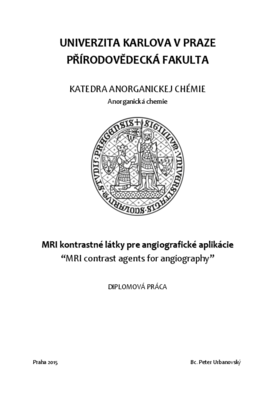MRI kontrastné látky pre angiografické aplikácie
MRI contrast agents for angiography
MRI kontrastní látky pro angiografické aplikace
diplomová práce (OBHÁJENO)

Zobrazit/
Trvalý odkaz
http://hdl.handle.net/20.500.11956/64412Identifikátory
SIS: 144816
Katalog UK: 990020059240106986
Kolekce
- Kvalifikační práce [21483]
Autor
Vedoucí práce
Oponent práce
Vojtíšek, Pavel
Fakulta / součást
Přírodovědecká fakulta
Obor
Anorganická chemie
Katedra / ústav / klinika
Katedra anorganické chemie
Datum obhajoby
10. 6. 2015
Nakladatel
Univerzita Karlova, Přírodovědecká fakultaJazyk
Slovenština
Známka
Výborně
Klíčová slova (česky)
MR, gadolinium, makrocyklické ligandy, makrocyklické komplexy, albuminKlíčová slova (anglicky)
MRI, gadolinium, macrocyclic ligands, macrocyclic complexes, serum albuminSúčasná diagnostická metóda magnetickej tomografie (MRI) používa kontrastné látky typu T1 založené na komplexoch Gd3+ . Pre vysokú toxicitu voľného Gd3+ sú požadované jeho komplexy, ktoré sú termodynamicky stále, kineticky inertné a ľahko vylúčiteľné. Táto práca zhŕňa poznatky o novej kontrastnej látke založenej na ligande typu DO3APR (1,4,7,10-tetraazacyklododekán-1-methyl(alkyl)fosfínová-4,7,10-trioctová kyselina) s postrannou hydrofóbnou dibenzylamino skupinou, ktorá je schopná reverzibilnej interakcie s makromolekulou sérového albumínu. Stabilita suprakomplexu je závislá na hodnote pH, t.j. na protonizácii pendantnej amino skupiny komplexu (pKA = 5,6) a táto interakcia bola potvrdená z 1 H-NMRD profilu a fluorescenčnou analýzou. Látka bola testovaná pre jej angiografické vlastnosti in vivo na modelu potkana. Ďalej boli charakterizované komplexy ligandu s niektorými trojmocnými lanthanoidmi (Nd3+ , Eu3+ , Tb3+ , Dy3+ , Er3+ ) rôznymi metódami (XRD, luminiscencie, UV-VIS, 1 H-, 17 O- a 31 P-NMR). Po odstránení benzylových skupín bol získaný ligand, ktorého Ln3+ komplexy vykazujú pH závislý PARACEST efekt. Tieto komplexy boli charakterizované metódami XRD, luminiscenčne a 1 H- a 31 P-NMR. Ďalej boli pripravené nové ligandy s modifikovanou dĺžkou pendantného ramena a s postrannou dibenzylamino...
Modern diagnostic method magnetic resonance imaging (MRI) usually uses contrast agents T1-type, which are based on Gd3+ complexes. Due to severe toxicity of free Gd3+ , it is desired to have thermodynamically stable and kinetically inert complexes with fast elimination from the body. This work summarizes information about a novel contrast agent based on ligand DO3AP (1,4,7,10-tetraazacyclododecane-1-methyl(alkyl)phosphinic-4,7,10- triacetic acid) with pendant hydrophobic dibenzylamino group which is able to interact hydrophobically with the macromolecule of serum albumin. The stability of supracomplex is dependent on pH value, i.e. on the protonation of the pendant amino group of the complex (pKA = 5.6) and this interaction was confirmed from 1 H-NMRD profile and fluorescent analysis. The compound was tested for its angiographic properties in vivo on rat model. Furthermore, other complexes of the ligand with trivalent lanthanides (Nd3+ , Eu3+ , Tb3+ , Dy3+ , Er3+ ) were characterized by various methods (XRD, luminescence, UV-VIS, 1 H-, 17 O- and 31 P-NMR). The cleavage of the benzyl groups affords ligand whose Ln3+ complexes possess pH dependent PARACEST effect. These complexes were characterized by XRD, luminescence and 1 H- and 31 P-NMR. Moreover, the novel ligands with modified length of pendant...
